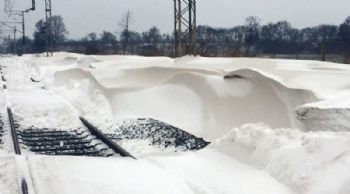
Network Rail says that with temperatures dropping across Britain, it is preparing to keep passengers moving in cold weather, adding that some of its biggest concerns are high winds blowing objects on to the line and heavy rain causing flooding and landslips (
www.networkrail.co.uk).
“Such incidents mean trains must stop until the line is cleared and a thorough safety inspection of the track is carried out.
“Low temperatures can also cause points to freeze up, preventing trains from accessing certain routes or platforms.”
To help keep passengers moving, Network Rail operates a special winter fleet. T
his includes: 10 snow and ice treatment trains (SITTs) fitted with snow ploughs, hot-air blowers, steam jets, brushes, scrapers and jets for heated anti-freeze and compressed air to quickly de-ice tracks; and 12 independent snow-plough locomotives to clear deep snow from the tracks — plus a number of mid-range ploughs.
“We have also attached heaters and NASA-grade insulation to points to prevent ice forming, and we have added protective covers to 4,000 points and 2,500 points motors to keep snow out and prevent damage by ice falling from trains.
"Furthermore, thousands of our people patrol the tracks day and night to clear snow and ice from junctions and tunnels, while remote temperature monitoring and a helicopter fitted with thermal-imaging cameras identify points heaters that are not working effectively.
“Anti-icing fluid and heating strips are used on live conductor rails to prevent ice building up and preventing trains from drawing power; and train companies run empty trains through the night to help keep tracks clear.
"Moreover, passenger trains can be fitted with snow ploughs capable of clearing up to 8in of snow; if it is deeper, we send in our fleet of dedicated snow ploughs.
"Major routes that are most at risk have been fitted with fences that prevent snow blowing onto the tracks.”
Furthermore, a network of hundreds of monitoring stations provides real-time weather data, enabling Network Rail to respond to conditions as they develop.
The company’s winter preparedness regime begins in September each year, when special trains and equipment are fully checked and any repairs are carried out, and contingency plans are reviewed and agreed with train operators.